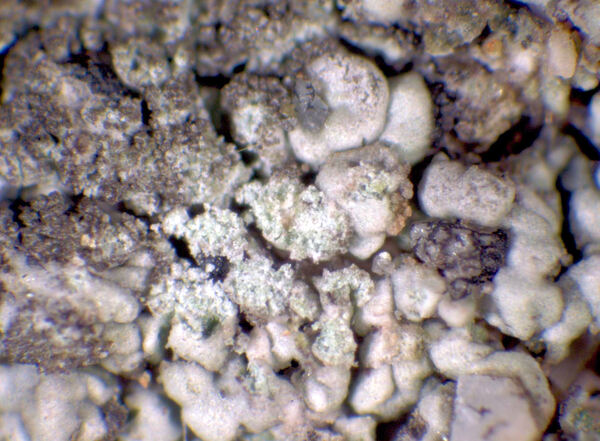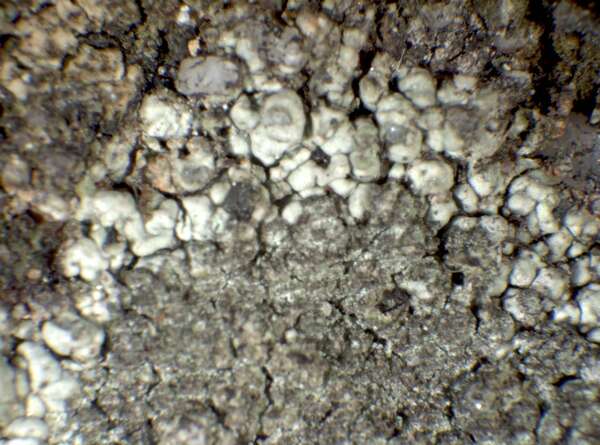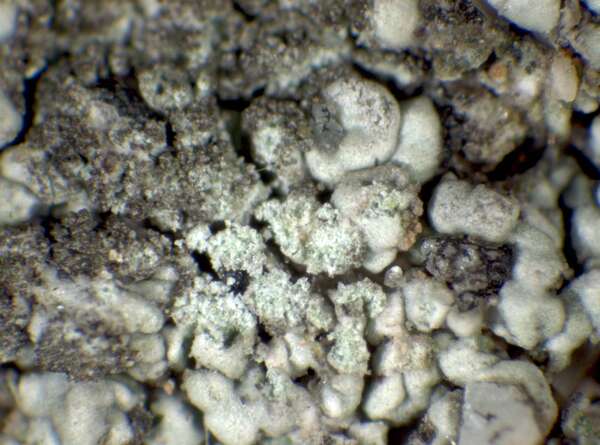Fuscidea recensa (Stirt.) Hertel, V. Wirth & Vězda
in Wirth, Beitr. naturk. Forsch. Südwestdeutschl., 31: 92, 1972. Basionym: Lecidea recensa Stirt. - Scottish Natur., 5: 219, 1879.
Synonyms: Fuscidea curvula (H. Magn.) Hertel; Lecidea arcuatula (Arnold) Nyl.; Lecidea curvula H. Magn.
Distribution: N - TAA (Thor & Nascimbene 2007, Nascimbene & al. 2022), VA, Emil (Tretiach & al. 2008, Fariselli & al. 2020).
Description: Thallus crustose, episubstratic, pale grey to brown, rarely almost white or red-brown, continuous to rimose-areolate, with convex, 0.1-0.5 mm wide areoles, often sorediate, forming regular patches to 2 cm across, usually delimited by a dark brown prothallus. Soralia at first discrete, 0.2-0.5(-0.7) mm wide, then confluent, the young soralia whitish but soon becoming brown (greenish where abraded), with granular 20-30 µm wide soredia. Medulla white, I-. Apothecia rare, black or brown, lecideine, sessile and constricted at base, 0.5-1(-1.2) mm across, with a flat to slightly convex disc, and a thin, persistent, often flexuose proper margin. Proper exciple thick, uniformly brown; epithecium brown; hymenium colourless, 55–65 μm high; paraphyses simple, 1.5-2 μm thick at mid-level, the apical cells only slightly swollen, to 3 μm wide, without a pigmented cap; hypothecium colourless. Asci 8-spored, clavate, with a thin external and internal K/I+ dark blue cap surrounded by a thick K/I+ pale blue apical cap, and with a K/I- apical tube in tholus, Fuscidea-type. Ascospores 1-celled to 1-septate, hyaline, narrowly ellipsoid to kidney-shaped, curved, 9-12(-14) x 3-4(-5) μm. Photobiont chlorococcoid. Spot tests: thallus and soredia K-, C-, KC-, P-; medulla UV+ white. Chemistry: divaricatic acid (major) nordivaricatic acid (traces).Note: on hard siliceous rocks in humid, sheltered sites, usually below the subalpine belt; overlooked in Italy, being often sterile. For the record from Valle d’Aosta see Nimis (1993: 301).
Growth form: Crustose
Substrata: rocks
Photobiont: green algae other than Trentepohlia
Reproductive strategy: mainly asexual, by soredia, or soredia-like structures (e.g. blastidia)
Most common in areas with a humid-warm climate (e.g. most of Tyrrenian Italy)
Commonnes-rarity: (info)
Alpine belt: absent
Subalpine belt: absent
Oromediterranean belt: absent
Montane belt: very rare
Submediterranean belt: extremely rare
Padanian area: absent
Humid submediterranean belt: absent
Humid mediterranean belt: absent
Dry mediterranean belt: absent

Predictive model
Herbarium samples
Growth form: Crustose
Substrata: rocks
Photobiont: green algae other than Trentepohlia
Reproductive strategy: mainly asexual, by soredia, or soredia-like structures (e.g. blastidia)
Most common in areas with a humid-warm climate (e.g. most of Tyrrenian Italy)
Commonnes-rarity: (info)
Alpine belt: absent
Subalpine belt: absent
Oromediterranean belt: absent
Montane belt: very rare
Submediterranean belt: extremely rare
Padanian area: absent
Humid submediterranean belt: absent
Humid mediterranean belt: absent
Dry mediterranean belt: absent

Predictive model
| Herbarium samples |
 Index Fungorum
Index Fungorum
 GBIF
GBIF





